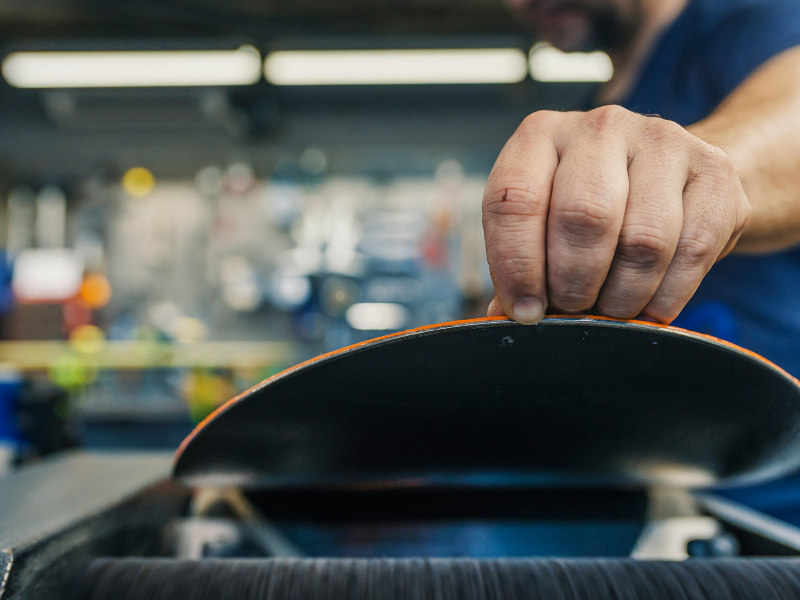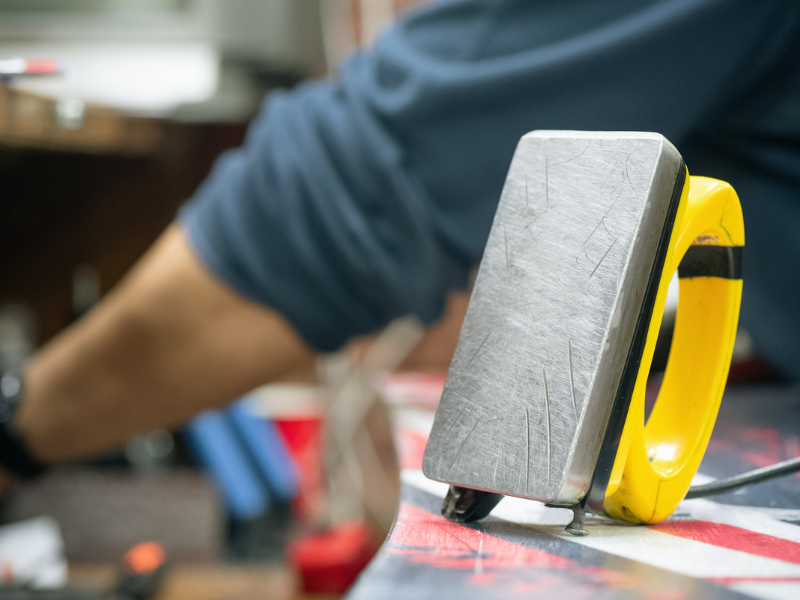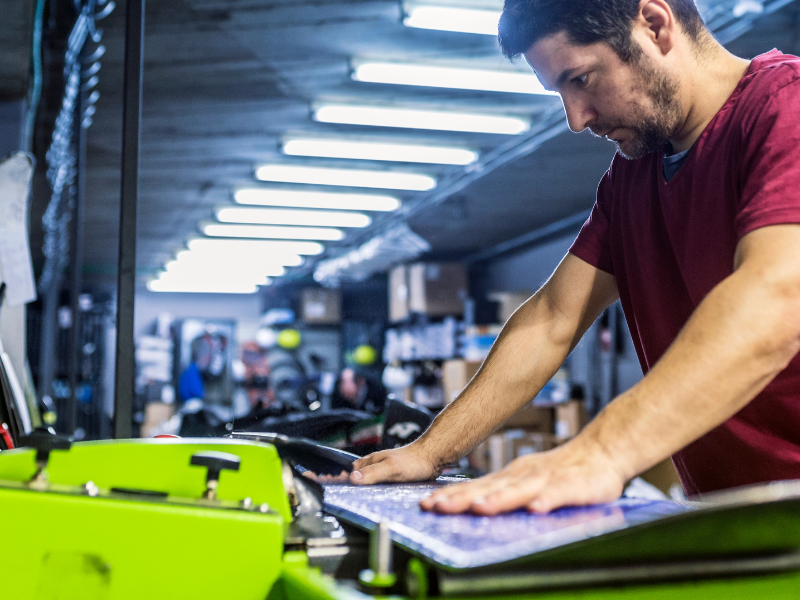I can hardly believe I’m getting my snowboard ready for the season. Unfortunately, I saw some burrs on the edges that I'm going to have to smooth out. But it made me wonder just how long snowboards last - repairs and all. Here’s what I found.
The average snowboard lasts between 150 to 200 days of riding. A snowboard's performance peaks during the first 75 to 100 days of riding, after which performance starts to gradually decline. The lifespan of a snowboard is largely influenced by the care, usage, location, and quality of the snowboard.
While it's great to know the average lifespan of a snowboard, it's unrealistic to think anyone would track their days riding as a way to gauge when they'd need a new snowboard. And with so many variables controlling its longevity, days become irrelevant.
The better solution is to know the signs of when to replace your snowboard - here's what you need to look for.
Check out Kenver's extensive selection of snowboards here:
Kenver's Snowboard Collection
3 Signs You Should Replace Your Snowboard
With so many factors playing into the condition of a snowboard, it's difficult to gauge when you should replace it, especially if you're a beginner. And believe it or not, if you're new to snowboarding, this generally means your snowboard will have a longer lifespan.
The old hands of snowboarding, those with a lot of experience, tend to put more force on their boards, which means it doesn’t last as long. A beginner’s board usually lasts up to 20% longer because they use less force on their snowboards.
So if you're new to the sport, you at least have one advantage over the pros.
But even a beginner might have a season or two under their belt, and it can be challenging to know if you need to replace your board or not. If that sounds like you, here's what you need to look for.
1. Your Snowboard's Lost its Pop; Observe the Camber and Rocker
The “pop” of a snowboard refers to the energy and rebound that the snowboard has. It’s this pop that gives life to your snowboarding. It's one of those things you have to experience just one time to be able to immediately recognize every time.
When your board's lost its pop, it will no longer behave quite like itself when you're riding - and it will start to feel flat.
A Flat Board Needs Replacement
While "flat" in the context of pop, is more about feel, a physically flat board is also a strong sign that it's near the end of its life and needs to be replaced.
When you put your snowboard down on a flat surface, it’s supposed to have “camber”, which is the curve in the board that helps it glide across the snow. A snowboard’s “rocker” increases the control that you have over the board.
A new board’s base has a curve between the contact points on either end of the snowboard. This curve “lifts” the board away from the flat surface. However, as you use the board, this camber straightens until it is flush against the flat surface.
But you don’t have to wait for your snowboard to be so worn out that its camber/rocker is wholly gone before getting a new snowboard.
Pop, camber, and rocker all sound like a new lineup for Rice Crispie Treats, but when any of the three go out on your snowboard, it can be dangerous.
So if you are seeing any of these signs of wear, at least have your local shop check it out, or start the process of finding your next snowboard.
2. Edges Stay Dull and Your Snowboard Feels Loose
If your bindings are starting to loosen up, or your edges are dull, these are usually good indicators that it's time for a new board.
Your Edges Won't Stay Sharp
The edges of a snowboard improve control when you're carving turns. Over time, the metal on the edges will start to erode and become blunt, which means they can no longer grip the snow as well as they used to.
Some of this is certainly fixable - either using a diamond stone for dings or an edge tuner to sharpen. But, if you persist through dull edges, you'll lose control of your turning ability - you'll find yourself sliding out more often than you're used to.
And believe me, I'm all for repairing anything that can be, but control is one of the most important safety factors while snowboarding. So it's critical to never jeopardize it.
So, when the edges of your snowboard are dull, beyond the point of sharpening, it's time for a new one.
Your Bindings Feel Too Loose
If you're noticing that your bindings are also coming loose more often, this is another sign that you need a new board.
If your bindings are feeling far too loose compared to your first day, it can mean the screws are stripping or that the board is losing its integrity. This can be incredibly dangerous, and another major factor in losing control of your board entirely.
3. Extensive Scrapes and Dings On Your Snowboard
Of course, accidents happen, and you'll inevitably strike debris above and below the snow. Many can be mended - whether on the base or edge of your snowboard.
But, if your board starts to look like swiss cheese, with too many gouges, cracks, major chips, and scrapes, it's probably time for a new one.
Even those pesky burrs that form on the edges are sometimes beyond the magic and power of the diamond stone.
Not to be overlooked, if your base is dry or peeling, this is also a sign your board needs to be replaced. If this happens, you can blame your wax or lack of wax.
If you’re unsure whether your snowboard can be repaired, take it to a professional to make sure. What may seem to you to be something minor may mean that your snowboard is a write-off, and it’s best to learn that when you’re in a snowboard shop and not shredding it.
A 1970s Camaro might look sweet with a few dings and scratches, but that same couldn't be said of your snowboard.
How to Take Great Care of Your Snowboard
The most important way to make your snowboard last is by taking care of it. Yeh, it's a bit trite, but we've all seen and been the people that throw their board in the trunk, rest heavy items on top of it, or leave it in less-than-ideal climates.
So let this serve as your reminder to take care of your snowboard. Here's your checklist of things to do to help your snowboard survive even more seasons:
- Properly store your snowboard - in the off-season especially, find a dry and cool place, and never your garage.
- Wash your board regularly - Every few days or after a session, try to remove all dirt and wax from your base. This will help you glide better. Just be sure to use a soft cloth and mild soap - dish soap works great. Coarse fabrics and harsh solutions will damage your board otherwise.
- Wax your snowboard - every 3 to 5 days of riding or when you see the performance start to decline. A good waxing can make an old board feel new again. And whatever you do, don't use a rub-on wax. If you've never waxed a snowboard before, it's rather simple, and can be done by anyone in just 9 steps.
- Tune your edges - at least once per season, but more often if you're an experienced rider or live in a climate with rocks, you'll want to make your edges smooth again.
A Quick Aside About Sharpening Edges
In general, sharpen your snowboard's edges at least once a year. If you ride quite a bit, increase this frequency.
If the edge of your snowboard feels blunt to the touch or has burrs (little uneven pieces) of your snowboard, and it feels blunt or has "burrs" (little uneven pieces) you'll need to get your edges sharpened.
Edges and general care aside, perhaps the most important step to taking care of your board is how you get it ready for the season, which deserves a section of its own in this article.
5 Steps to Get Your Snowboard Ready for the Season
Where you start the season usually has a compounding effect on the condition of your snowboard at the end of the season. Here's a quick guide if you're getting your snowboard out of storage and tuned up for the season.
- Clean your base - You can use a base cleaner/degreaser and a soft cloth or rag but mild soap can work wonders as well.
- Clean the edges - Look for any rusty spots, and remove them carefully with a scouring pad. Emphasis on careful - avoid touching the base as much as possible.
- Knock off any burrs - Run a diamond stone over the edges, paying close attention to any dings. Then sharpen your edges with an edge tuner.
- Wax the base – If you know the climate you'll snowboard in, then go with a cold-rated or hot-rated wax. But if you aren't sure, all-temperature waxes are a safe bet. And again, don't use a rub-on wax - it's a waste of your time, energy, and money.
- Check your bindings - From your bolts to your straps, make sure they're still fastened well, and that nothing has started to deteriorate during the off-season.
Even if your snowboard was in immaculate condition when you stored it at the end of last season, you'll still need to ensure it’s in top shape for each new season.
Getting your snowboard ready is simple, and you can usually do it at home. But if you’re in doubt, take your board to your shop and have them look it over and tune it for you.
Unfortunately, even if you only use your snowboard a couple of days each season and take the best care of it, it will still wear out with time – it may just take longer, especially if it is a high-quality snowboard.
Is a 10-Year-Old Snowboard Still Good?
The age of a snowboard has no bearing on its condition, so as long as a snowboard was regularly maintained throughout the decade, and meets the usage limitations, generally 150-200 days of riding, then the snowboard could still be considered "good."
This question gets asked quite a bit, and it's usually by someone who owns a board, but just hasn't used it in some time.
A board that sits in storage for extended periods is going to lose its shape. These bends could give you trouble keeping the snowboard under your control and risk injury.
However, should the older board still has its pop and flex, and its edges are still sharp (or can be sharpened), you can use an older snowboard or buy one secondhand at a fraction of the price it would otherwise have cost.
That's a long way of saying there isn’t a simple “yes” or “no” answer to this question as there are so many variables impacting whether a 10-year-old snowboard is still good to use or whether you should get rid of it instead.
If your snowboard hit the decade birthday or you're looking to buy one secondhand, you'll want to pay close attention to the 3 signs a snowboard needs replaced, detailed at the beginning of this article.
Those signs include the feeling and look of being flat, an overly dull edge and loose bindings, and damage to the board that's beyond repair and safety standards.
Your Snowboard's Lifespan Mostly Depends on You
With the right amount of care, your snowboard could last you a season or a lifetime.
It all comes down to how often you ride, where you ride, how you ride, and, most importantly, how you take care of your board when you're not riding.
Your equipment is essential and can mean the difference between enjoying a day on the slopes or getting injured. Always ask your local snowboard shop for advice or help when you need it or when your board requires maintenance.
Once you know your equipment’s sorted, all you have to do is show up to have the time of your life.
Check out Kenver's extensive selection of snowboards here:
Kenver's Snowboard Collection



